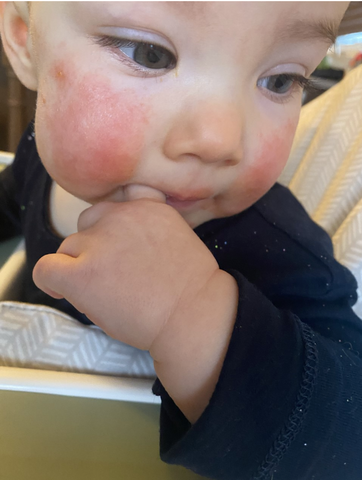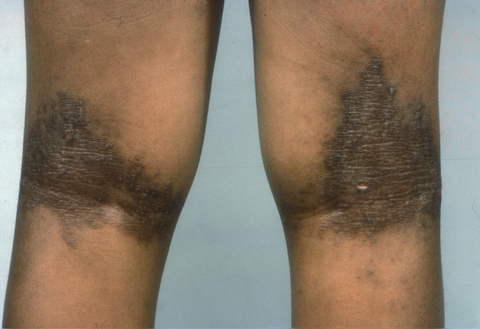
Eczema is a common childhood skin condition that affects up to 30% of children. Most children who are going to have eczema experience their first flare before the age of 5. The most common time for eczema to start is between 6-18 months. So what does eczema look like on babies? Let’s explore some of the common symptoms of baby eczema.
Understanding Baby Eczema Symptoms
There are many risk factors for eczema, the main one being having one or both parents who have eczema. Symptoms of eczema can look different from baby to baby but there are some symptoms that are typically seen, including dry, scaly, itchy red skin. Different types of baby eczema can also be weeping or oozing, which results in the formation of a crust on the surface of the skin.
Eczema tends to present first on the cheeks, abdomen, and back. As your baby gets older, it is common for them to develop it behind their knees, and in their elbow creases. As they become able, babies frequently scratch eczema, sometimes even to the point of making it bleed. Eczema does not tend to present in the diaper area, so this can be helpful for figuring out if the rash your baby has is eczema or not.
Soothing eczema can be challenging for a variety of reasons. Signs of baby eczema are not always super easy to recognize. Babies can get red cheeks from teething, and also from eczema. A baby can have dry skin, but not eczema.
Your doctor, midwife, or other healthcare provider can help to diagnose eczema, but keep reading to learn the symptoms of baby eczema to look for at home.
Most Common Symptoms of Baby Eczema
The most common symptoms of eczema are:
- Dry, scaly skin
- Red patches
- Oozing, or yellow crusting
- Itching
- Bumpy appearance
What Does Eczema Look Like On Babies?

This is a fairly typical mild to moderate case of eczema in a baby. Their cheeks are usually one of the first places to get eczema. While cheeks can get red from teething, that looks more like a flush. Redness from eczema looks like irritation and if you look closely, you can see there are some small red bumps as well. Redness can definitely be a sign of baby eczema, but redness alone does not mean it is eczema.

In babies 6 months and older we often find eczema behind their knees and in their elbow creases. It generally looks red, or darker, and scaly. Behind the knees and in elbow creases are usually itchy areas. If your baby is old enough, they may scratch at eczema patches. This itchiness can be another symptom of baby eczema vs dry skin.

This is what moderate to severe eczema can look like. Cheeks, forehead, eyelids and behind the ears are all impacted. It is red, scaly, itchy and has been oozing, as it has a yellowish crust. His skin also appears to be very dry.
Symptoms of Baby Eczema vs Other Skin Conditions
It can be hard to distinguish between symptoms of baby eczema and other skin conditions. The two other skin conditions that I find parents confuse the most with eczema are baby acne and cradle cap.
Symptoms of Baby Acne
Baby acne also causes red skin and bumps, which can be red or white. Baby acne tends to present on the cheeks, nose and forehead. It is fairly common, and the cause is unknown. One theory is that it is the baby’s skin getting rid of the mom’s hormones the baby was exposed to during pregnancy. Baby acne can also be found on the chest and back. Baby acne tends to develop earlier than eczema, around 2 to 4 weeks of age, and usually resolves by 3-4 months of age.
Symptoms of Cradle Cap
Cradle cap is very common in newborns and young babies. It’s the common term for infantile seborrheic dermatitis and usually clears up on its own as babies grow older. Common signs of cradle cap include patchy scaling on the scalp, dry skin covered with flaky white or yellow scales, skin flakes and mild redness.
Types of Baby Eczema

There are 3 main types of eczema, some of which are more common in babies.
Atopic Dermatitis
This is the most common type of eczema seen in babies. It is eczema that tends to present on cheeks, abdomen and back first and then may progress to elbow creases, behind the knees and hands. It is what most people think of when they think about eczema; red, dry, scaly and itchy.
Contact Dermatitis
Contact dermatitis is a red itchy rash that results from contact with something; Laundry soap is a common culprit for babies. It is red and itchy, but it does not usually have bumps or is scaly. It also will resolve when the trigger is removed, so it tends to not be present as long as eczema.
Seborrheic Dermatitis
Seborrheic dermatitis is commonly known as cradle cap. Cradle cap tends to present on the scalp only, but it can travel down to the forehead as well. It causes crusty, flaking and oily patches. Cradle cap is typically not itchy and does not bother the baby. Cradle cap can be present from shortly after birth, and tends to clear up by 6 months of age. The peak age for cradle cap is 2-3 months.
How Eczema is Diagnosed
If you think your baby has eczema, and you’re seeing symptoms of baby eczema that go beyond mildly red cheeks, it is important to take them to your doctor or healthcare provider to get a diagnosis.
Most doctors can diagnose eczema just by looking at it, based on its appearance, your description of your baby’s symptoms, your baby’s health history and your family history of eczema. There is no test to diagnose eczema.
Need Help Now? Explore Home Remedies for Baby Eczema
There is plenty you can do if you suspect your baby has a mild eczema or while you are waiting for your doctor’s appointment.
The number one thing I recommend to address symptoms of baby eczema is to remove scented products from the house. This included cleaning products, air fresheners, and soaps. Laundry soap can be a big trigger for babies with eczema and sensitive skin. Look for one that is fragrance free and gentle enough for baby’s skin. I suggest Seventh Generation Free and Clear.
Finding skincare that is designed for sensitive skin and won’t aggravate eczema is also very important. There are some really good ingredients for baby eczema to look for. A skin cream that contains these soothing ingredients can do wonders to help calm the skin, and ease itching.
Beyond topical treatments, it is important to figure out what your baby’s triggers are so that you can remove them and get to the bottom of the cause of their eczema. Common baby eczema triggers are foods like dairy and eggs, fragrance, and baby getting too hot.
Feeling overwhelmed by all of the symptoms, causes and possible treatments for your little one’s eczema? Explore our Eczema Eraser Masterclass to learn more about how to identify eczema triggers and start treating eczema naturally at home.
